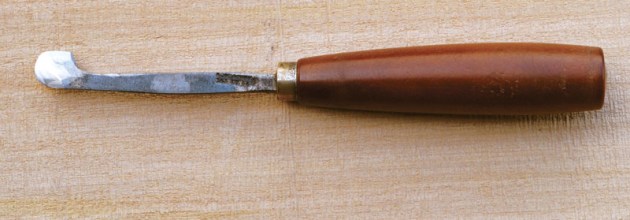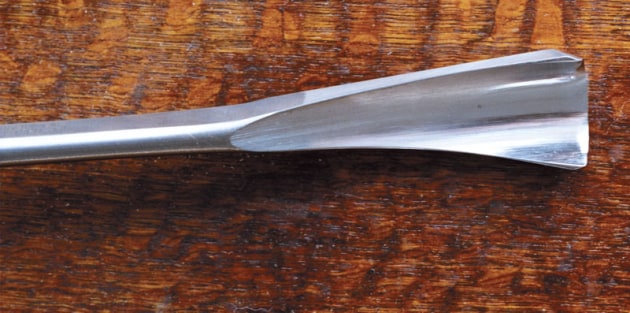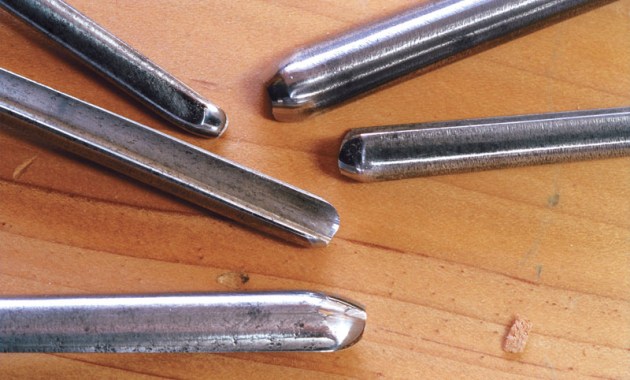Favourite carving chisels
A selection of fishtail chisels
Words and photos: Donald Powell
There seems to be a proliferation of power tools amongst woodcarvers today, but for Don Powell it’s the traditional tools—chisels, gouges and knives—which give him the most confidence and pleasure in his work. Amongst his collection he has several familiar favourites and some others which are quite unusual.
Fishtails
Many of my chisels are fishtails. To my mind these are the thoroughbreds of the carving chisel world. A good fishtail is a delight to use and they are my absolute favourites. They are very comfortable to hold and use, and follow the curves in wood with a satisfying flow. Their corners can handle detail and are perfect for serifs when lettering.
The fishtail is often regarded as a finishing tool, but I have had some made up for roughing-out tools and they are a great success. The long corners on the large fishtail gouges form a very efficient cutting blade when used with a slicing motion.
Texturing tools
I have put together a set of No.11 chisels which I prefer over V-tools for carving hair and other texturing work. These are assorted old English chisels, Addis and Herring brands, which were beautifully made in their day, perhaps 80 years ago. These makers are long gone, but their chisels turn up on the secondhand market.
Mine have fine steel with thin walls and a deep U-shape. I round the corners of the blades to better facilitate the flowing, rolling technique I use to produce cuts of varying widths and depths when carving hair. Working with a range of sizes gives more variety and depth to the work; it really enhances what is in fact an exercise in texturing.
Scorps
I have three scorps: 7mm, 3mm and 2mm. These small, round-ended tools are really quite versatile. They can be used in hand-held carving like a bent knife is used in whittling, or with the potato peeler’s cut, the curved blade working as a gouge. The scorp also functions like a spoon bent gouge in scooping out cavities and deeply recessed areas.

My particular use for it is carving between the tops of horses’ legs when the grain and position seem to work to defy one’s effort. The tool can be very tricky to sharpen properly so I ensure that I am meticulous in keeping them honed on a strop when in use.
Adapted tools

I came across a home-made tool in England which I think was derived from the bent skew chisel designed by Fred Cogelow. I made a similar one myself (shown above) by grinding an old flat carpenters chisel to the shape required, producing a very rugged chisel which cuts and slices, and can be pushed and pulled. It is very good for developing deep recesses or when roughing out and removing wood between the legs of a standing figure. The flat blade is bevelled on both sides and the cutting edge curves along the full front and bottom radius of the blade. The chisel is very easy to manipulate and sharpen.

I subsequently made a different version (above) which has become a favourite of mine for finer detailing. I used a secondhand bent chisel that was pretty useless for what it was designed for. The shape of the shaft was perfect for my purpose, enabling the blade to be comfortably manipulated and efficiently worked in awkward areas where a straight shaft would cause the hand and handle to foul the work. Its design gives it very good control while giving a clear vision of what you’re doing. It is very handy for fine paring, slicing and push cuts. I often use it for detailing eyes and I have lost count of the number of times that students in my workshop have asked, ‘Where did you get this tool?’.





